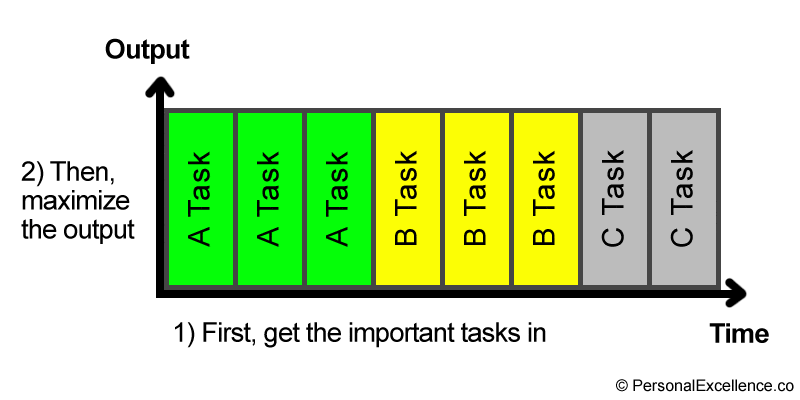
(Image: Lukas Blazek)
Do you often feel that you’re short of time? Say you scheduled 3 tasks for today. You start the day full of energy to tackle those 3 tasks. At the end of the day, you have barely completed the first task because there were other things that demanded your attention.
The first thing you need to recognize in time management is you have the same amount of time as everyone in the world. Steve Jobs, Bill Gates, Warren Buffett, Tiger Woods, Michael Jordan, and every person in this world has 24 hours every day and 365 days a year, just like you do. Time is not a limited commodity because it is always there, unfolding every second before you. There is no time to manage. Time is just what it is. You cannot arrange your “time,” make an hour shorter or longer, or make time faster or slower.
Time is an artificial human construct
The concept of time is an artificial human construct. It is a system of measurement invented by Man to give meaning to what is before us. Centuries, decades, years, months, weeks, days, hours, minutes, seconds, and milliseconds — these are just terms that we created to assert control over the fluidity of time.
And it is a decent creation too. The construct of time has helped us establish order and understanding among all humans as we lead our lives in an orderly fashion. When you say “Let’s meet at 9am this Friday,” your friends understand you because we have a common understanding of how time works, as demarcated by weeks/days/hours/minutes/seconds.
But in reality, time is just what it is. You do not need more time nor do you have a lack of time. Time is always there. You have all the time before you.
Reframing the problem in Time Management
What you do have, however, are activities that you need to complete by the end of each day. What you need are better skills and techniques to manage those activities and ensure that they get completed within the designated time frame. What you need to learn is task and self-management, not time management.
Here I bring you a quote from David Allen, author of Getting Things Done:
“You can’t manage time, it just is. So ‘time management’ is a mislabeled problem, which has little chance of being an effective approach. What you really manage is your activity during time, and defining outcomes and physical actions required is the core process required to manage what you do.”
The topic of task management is so big that it is not possible to cover it in just one article. I will start by sharing the basic concept of task management, followed by articles that build on this concept. I will also be sharing task and self-management frameworks and techniques you can apply in your life. :)
Because “time management” is a ubiquitous term, I will use it interchangeably with “task management” in this article and other articles on this blog. However, you know what I really mean — that “time management” is a misnomer, and it’s really task and self-management we are looking at. :)
Two Pillars of Time Management: Effectiveness and Efficiency
The core of time management can broken into two parts: effectiveness and efficiency.
- Effectiveness means doing the important. It means to prioritize, to focus on what is needed to deliver the results, and to say no to things that are not in line with your bigger life goals.
- Efficiency means to produce maximum output with minimum wasted input. This means the ability to do things quickly and accurately. To get a higher output using the same or smaller investment of time and resources.
The essence of time management is to first, work on your tasks in order of importance. Second, maximize your output from those tasks, as I have illustrated below:

A, B, C tasks refer to their priority of importance, with A tasks being the most important, B tasks being second most important, etc. So here, you want to work on the most important tasks first (effectiveness), then maximize your output for each task (efficiency).
First Pillar: Effectiveness
Many people attribute their time management failures to being inefficient, when the real opportunity lies in being more effective. Effectiveness can be applied in two steps: Firstly, by doing the important tasks over the less important tasks. Secondly, by focusing on the important aspects of the important tasks. The essence of effectiveness is prioritization. Let us explore each in turn.
Step #1: Do the important tasks first
Effectiveness happens when you work on your tasks in order of their priority. If you often have insufficient time for something (exercise, relationships), that’s because you have not prioritized it enough. You chose to do other things over it, and that’s why you “don’t have enough time” for it. Maybe you don’t recognize the relative importance of this particular activity over the other things you are busy with. Or maybe you are trapped in the routine of doing unimportant things.
For example, perhaps you may have been meaning to go to the gym after work, but work demands hold you up at work. Here, you have prioritized your work over exercise. Perhaps you did a quick assessment of the pros/cons of working late versus exercising and decided that the former is a better choice over the latter. The urgent nature of the work demanded your attention, whereas exercise can always be done at a later time.
Whatever it is, it is your personal choice to do the things you did. Ownership of your choices is needed to for you to make progress in time management. Some people spend their days on random activities such as mindless web surfing, chatting, watching TV, and lazing. At the end of the day, they look back and wonder where their day has gone. Was there an issue with their effectiveness? Absolutely. They chose to prioritize those random tasks over what is really important to them.
So here you want to ask, “What’s really important to me? For the tasks I’m doing now, are these really the most important tasks I could be doing in my life?”
Step #2: Do the important steps within the task
Let’s look at the second step — focusing on the important aspects within the task.
Say you need to do a school presentation and you have prioritized it over other tasks on your list. While working on the presentation however, you spend most of your time on less important sub-tasks. Instead of working on quality of your content, you spend 50% of your time changing minute details like having matching font colors and correcting text alignments on each slide.
Now I’m not saying that it is not important to have a professional and consistent look in your materials. I have done my fair share of presentations in school and at work, at least a few hundred of them.
However, you want to get clear on the goal and priority of this task. The goal of this presentation is (let’s say) to get an A grade. The components that make up the grade are your content, delivery, and audience engagement. The design of the slides perhaps influence audience perception on an intangible level.
Given that, the essence of this presentation task is the content and delivery, not the design. There is a difference between spending 10% and 80% of your time on design. Unless your slide design looks absolutely horrendous, these little things are not going to matter in the long run. The more presentations I do, the more time I spend time on the content, idea organization, my delivery, and possible questions rather than smaller details like formatting, look, and feel.
I remember when I first started doing presentations in university, I wasted so much time on the design and formatting that did not make a big difference in the big picture. I would put off working on my delivery, meaning how I would present, to the last thing on my to-do list. It was a huge mistake, because I ended up having little to no time to work on my speech and delivery, and these were so crucial.
Nowadays, my presentations can be simple black text against a white background depending on the people I am presenting to. Of course, if I’m presenting to a crowd that perceives design as part of the content, I’ll put effort into the design. In the end, it boils down to prioritizing the steps that matter.
Second Pillar: Efficiency
Efficiency, which is about doing things in a quick and accurate way, has a smaller impact than improving effectiveness. That is because there is a limit to how fast and how much we can do within our human capacity.
Say you have a report to type. It is a 6,000-word report which you have already written on paper and you need to type it out. With a typing speed of 60 WPM (Words per Minute), you get the job done in 100 minutes. If you try to type faster at 65 WPM, you will finish the job in 92 minutes, which shaves 8 minutes off your original timing, which is good but not a lot in the bigger scheme of things. That is assuming you do not make more errors from the increased speed!
On the other hand, improving your effectiveness (to work on the right tasks first) can help you get way bigger time savings. Here, an example of effectiveness is to type the report directly in your computer to begin with instead of writing it on paper and then transferring it to the computer, which creates an additional step. You can use a pen scanner to scan the text, though it is subject to errors so it may not be as good as the former. You can even delegate or outsource the data entry to someone, which gets the task done at no expense of your time. When you’re in a higher level position where time is a constant scarcity, it pays to delegate your tasks for a fee, because the time gains you get are far more valuable than the cost of hiring.
Returning to example above, you can type the report directly in your computer to begin with instead of writing it on paper and transferring it to the computer, which creates an additional step. You can use a pen scanner to scan the text, though it is subject to errors so it may not be as good as the former. You can even delegate or outsource the typing to someone, which gets the task done at no expense of your time.
Improving efficiency is definitely important, but before we work on efficiency, we should ensure that we are being effective. Effectiveness typically involves paradigm shifts in the way we think about our tasks, and changes in our approach. Efficiency involves an increase in speed, action, and precision.
Most people today make the mistake of working on efficiency, thinking that that’s all to time management. Effectiveness should come before efficiency to maximize our output.
In the end, when you work on improving Effectiveness and Efficiency, you make the best out of your life.
Read next: Put First Things First







![16 Things Successful People Do at the Beginning of Every Workday [Infographic]](https://personalexcellence.co/files/infographic-successful-people-every-workday-200x338.png)

 Thanks for reading. If you like my free articles, join my private email list and get my latest updates and articles sent right to your inbox.
Thanks for reading. If you like my free articles, join my private email list and get my latest updates and articles sent right to your inbox.